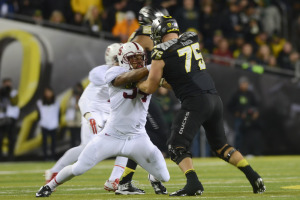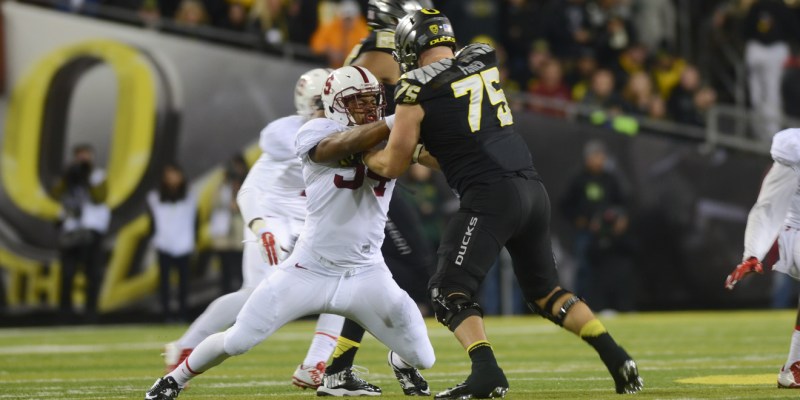Before last week’s loss to Oregon, Stanford’s defense had held opponents to fewer than 30 points in 31 straight games — tops in the nation. Additionally, the Cardinal had limited the Ducks to a combined 34 points in their past two meetings. Last Saturday, Oregon routed Stanford to the tune of 45 points, the most the Cardinal had allowed since surrendering 48 to Arizona in October 2012. We asked football writers David Cohn, Do-Hyoung Park and Vihan Lakshman: What happened to the Cardinal’s defense against Oregon, and can the holes that were exposed be fixed?

David Cohn: The Cardinal defense had an uncharacteristically rough game by the astronomically high standards that it had previously set over the course of two and a half years. Quite simply, the Oregon offense outplayed, outschemed and thoroughly dominated the Card to the tune of 525 total yards, 267 rushing yards and 8.3 yards per passing attempt. Mark Helfrich and his coaching staff exploited the thin Stanford defensive line by utilizing physical offensive line play and a powerful running back in Royce Freeman (19 carries for 98 yards).
In addition, Helfrich game-planned perfectly to allow Mariota and the passing game to take advantage of the absence of Zach Hoffpauir by targeting his replacement, freshman Terrence Alexander. Quite simply, Oregon maximized its talent with smart scheming to blast the Cardinal defense.
However, that being said, I think the holes that were exposed against the Ducks can at least be partially fixed, namely because none of the Cardinal’s final three opponents are anywhere close to as talented as Oregon. In particular, the Cardinal’s next opponent, the Utah Utes, have a potentially very one-dimensional offense, as quarterback Travis Wilson has struggled mightily when asked to air it out; Wilson notched a paltry 57 passing yards against Arizona State’s swarming defense while completing barely 50 percent of his passes.
While the Card’s depth issues on the defensive line will likely not go away, game-planning and better execution, coupled with more favorable matchups, can help Stanford regain its footing.
Do-Hyoung Park: Right off the bat: I don’t like this question. It’s a huge overreaction. It says that Oregon’s offense exposed Stanford’s defense, but nothing that went wrong against Oregon was stuff we hadn’t seen before; it was just a really good team that exploited the weaknesses that we had seen before.
We knew the defensive line would be iffy at best with all the injuries. We knew there would be shoddy coverage in nickel sets — Zach Hoffpauir wasn’t exactly a world beater in pass coverage when he was healthy, and Terrence Alexander is a true freshman, after all. We knew tackling could be an issue when Javorius “Buck” Allen and Nelson Agholor twisted and pushed Cardinal defenders around late in the game against USC.
It’s just that Stanford finally faced an offense and a quarterback that can properly exploit whatever weaknesses defenses have and make them pay (ironically, it was somehow a RichRod defense and a Mike Leach “defense” that actually did get the better of Oregon this season, but hey, this year’s Pac-12 is a total crapshoot anyway).
Let’s put it this way: It was like playing Madden against somebody who was playing with custom players, with all settings cranked up to 100 and who is looking at your half of the screen while you pick a play. Because Marcus Mariota is a cheat code, and Mark Helfrich is the guy down the block that you know will want to play everyone with his cheat team, but you play against anyway, because you can’t help but have a morbid fascination for the results.
That said, there really isn’t anything you can fix at this point in time. This defense, “holes” and all, was the No. 1 unit in the country, after all. You can’t just tell Hoffpauir, Aziz Shittu and David Parry to walk it off and get back in the game. You can’t expect Lance Anderson to have every answer to every situation.
Oregon just had better pieces, better tools and a better builder. But that’s not to say that what Stanford has isn’t sturdy and durable as well. If it ain’t broke, don’t fix it.
Vihan Lakshman: The Cardinal defense ran into one of the best offenses in the country, one that is clearly hitting its stride and just happens to feature, for my money, the most dangerous player in college football in Marcus Mariota. Do nailed it when he said that Stanford’s defense was not exposed against Oregon, but simply outplayed.
Did Stanford miss an uncharacteristic number of tackles? Did it get pushed around by an Oregon offensive line that put up a Stanford-esque performance? Absolutely. But those are not deep-seated flaws that were suddenly brought to the forefront; they were the result of a defense dealing with injuries that ran into an elite offense out for revenge.
To say that the beatdown that took place on Saturday at Autzen was a result of Stanford’s defense regressing would be a huge disservice to the beautiful offensive gameplan Scott Frost and Mark Helfrich put together, to the physicality of the Oregon front line and to the brilliance of Mariota through the air and on the ground. Heck, this game could have been even worse for Stanford if Mariota doesn’t uncharacteristically miss on four or five throws.
Stanford came into Eugene as, statistically, the number one total defense in the country, but the Card had not played any offense in the same universe as the Oregon team that showed up and played lights-out on that particular day. We have quibbled about this defense in the past, saying that it should force more turnovers or get more sacks, but the bottom line is that Oregon’s offense was the better unit and the healthier unit, just like Stanford was in 2013.
Going forward, I don’t expect teams magically to start racking up points on an “exposed” Stanford defense. A team as well-coached as Stanford will not consistently miss tackles like it did on Saturday, and the upcoming bye week should help the ailing defense to get healthier. Overall, I expect to see a very solid Stanford defense the rest of the season. Saturday’s game showed that it might not be the best defense in the country, but I would still take the Card’s defense over just about anybody.
For a Stanford defense that raised eyebrows at the start of the season when it experienced no drop-off in performance despite huge personnel losses, it’s notable that they haven’t faltered until now. Share with David Cohn, Do-Hyoung Park and Vihan Lakshman your optimism or pessimism on the subject at dmcohn ‘at’ stanford.edu, dpark027 ‘at’ stanford.edu and vihan ‘at’ stanford.edu.
